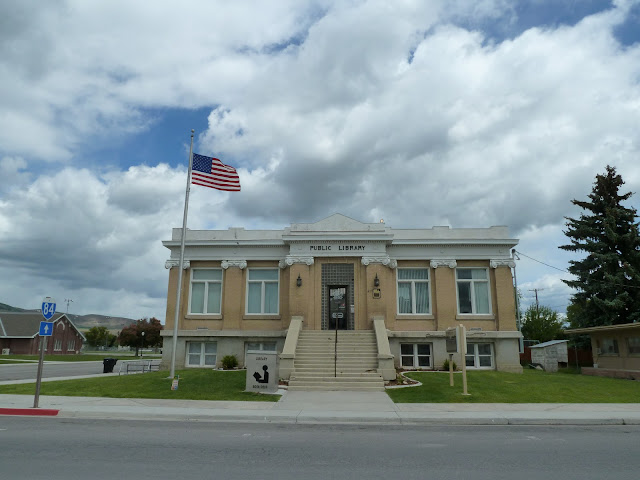 Give Andrew Carnegie his due, he bought nice libraries.
Give Andrew Carnegie his due, he bought nice libraries.The old penny pincher, who made millions on the backs of thousands of abused steel workers, had an attack of conscience in his declining years and gave a huge chunk of his fortune to thousands of local communities. In 1901 Ogden got $25,000.
Not entirely free, of course. The communities had to come up with operating funds and a location. Still, it was a great deal.
Those libraries tended to represent public architecture of the day -- Romanesque, sturdy, imposing. This is a LIBRARY, after all! Not some cheap honky tonk.
 Sadly, most of the Carnegie libraries are gone -- it has been a century, after all. Brigham City built its new library on the site of the old, saving only the facade. Ogden's went when the new one was built in the 60s.
Sadly, most of the Carnegie libraries are gone -- it has been a century, after all. Brigham City built its new library on the site of the old, saving only the facade. Ogden's went when the new one was built in the 60s.Then there's Garland.
That city's Free Carnegie Library (Carnegie wanted them free for all to use -- damn socialist!) was built and dedicated in 1914 and, by the miracle of being in a town that hasn't grown much, thus keeping expansion pressures at a minimum, has survived looking pretty much the same.
I drove up Thursday to take pictures of it with my large format and pinhole cameras (film still to be processed) but shot some with the digi too because it's just a darn cute little library.
 The library director, Danielle ("call me Dani") Rasmussen is justifiably proud. She brooks no talk of ever replacing it. Even real improvements come with some regret -- last year they removed the old boiler and installed a modern furnace, and she's sad that she lost all but two of the original ornate steam radiators.
The library director, Danielle ("call me Dani") Rasmussen is justifiably proud. She brooks no talk of ever replacing it. Even real improvements come with some regret -- last year they removed the old boiler and installed a modern furnace, and she's sad that she lost all but two of the original ornate steam radiators. The last renovation, before she took over, included a modern suspended ceiling "and one day one of the tiles was loose and I looked up in there and there's crown moulding!" she said. "Crown moulding! How beautiful!"
The last renovation, before she took over, included a modern suspended ceiling "and one day one of the tiles was loose and I looked up in there and there's crown moulding!" she said. "Crown moulding! How beautiful!"So she's plotting against the suspended ceiling.
The library keeps short hours -- it's closed Monday, doesn't open until 1 p.m. Still, there were half a dozen kids from the area waiting outside when it opened, and even after I'd hung around for an hour, timing 5-minute pinhole exposures, there was a steady flow of people. She's got a computer section, an audio visual area with a lot of VHS tapes, and the most gorgeous children's area I've seen taking up much of the basement (which I did not take a picture of, sadly), space that was freed up when the old massive boiler went.

The selection of books is small, but looks basic and I'm guessing inter-library loan handles special wants. She's got reading programs, Wheat and Beet Days activities, summer stuff for the kids, and other things going on.

I love their toilet. No, seriously. Every chance to remind muggles of literature.
Danielle, like Weber Librarian Lynnda Wangsgaard, is adamant that the library is a hugely important community center, not just a place to find a book to read.
She's currently going nuts trying to come up with ideas to celebrate the library's 100th anniversary next year. Maybe monthly observances? Ideas
 |
| Andrew Carnegie, in the library foyer |
Meanwhile, if you want to see a real, old fashioned (but nicely modern) library, something that would warm the cockles of even Andrew Carnegie's calloused heart, go take a look. Go west of the 4-way stop that is the center of town. It's on the right, just past the dead drug store, opposite the dead movie theater.
A bright island of life and literature.










































